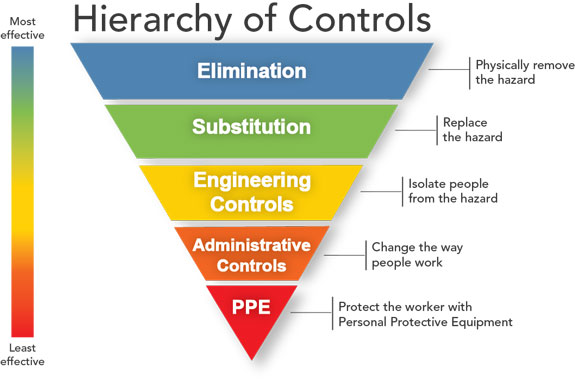Menu
What is a hazard?
What types of hazards are there?
How do I know if a hazard is dangerous to my health?
What are the main ways to control for hazards?
What are some examples of controls?
What is an exposure control plan?
Hygiene Hazards
What is a hazard?
A hazard is anything that has the potential to cause harm. The harm caused can affect buildings, equipment, individuals, or the environment. From an occupational hygiene perspective, focus is placed on hazards that can affect the individual.
^ Back to Top
What types of hazards are there?
To ensure a safe work environment it is important to be aware of the hazards that may exist in your workplace. Most hazards can be broken down into one of three categories:
| Hazard Type | Examples |
| Physical Hazards | Noise, Light, Temperature, Radiation. |
| Biological Hazards | Mould, Viruses, Blood Bourne Pathogens, Animal Allergens. |
| Chemical Hazards | Acids, Bases, Organic Vapours. |
How do I know if a hazard is dangerous to my health?
To determine if a hazard can result in adverse health effects, monitoring needs to be carried out through either personal sampling or area sampling using specialized equipment. The results from all monitoring are compared to WorkSafeBC regulations or other applicable standards to ensure compliance. If compliance is not achieved then the necessary controls need to be implemented.
^ Back to Top
What are the main ways to control for hazards?
The hierarchy of controls should always be used to eliminate or reduce exposure to hazards.

What are some examples of controls?
| Control Type | Examples |
| Elimination/Substitution | Remove the hazard from the work site or replace the hazardous material and/or equipment with less hazardous ones |
| Engineering Controls | Introducing designs or modifications to buildings, equipment, ventilation systems, and/or process to reduce exposure levels |
| Administrative Controls | Introducing policies, guidelines, safe operating procedures and/or exposure control plans |
| Personal Protective Equipment | Introducing gloves, respirators, hearing protection, lab coats, and/or steel toed shoes |
What is an exposure control plan?
Exposure Control Plans (ECP’s) function to protect staff and students from exposures to hazards by outlining important information regarding that hazard. More information on exposure control plans can be found at WorkSafeBC.
Occupational Hygiene (OH) exposure control plans can be found below:
- OH-ECP-001 Exposure Control Plan for Isocyanates (PDF)
- OH-ECP-002 Exposure Control Plan for Lead (PDF)
- OH-ECP-003 Exposure Control Plan for Heat Stress (PDF)
Additional exposure control plans can be found:
- For chemical hazard – Chemical Safety Resources webpage
- For Blood and Body Fluids and for Lab Animal Allergens – UBC Occupational & Preventive Health webpage